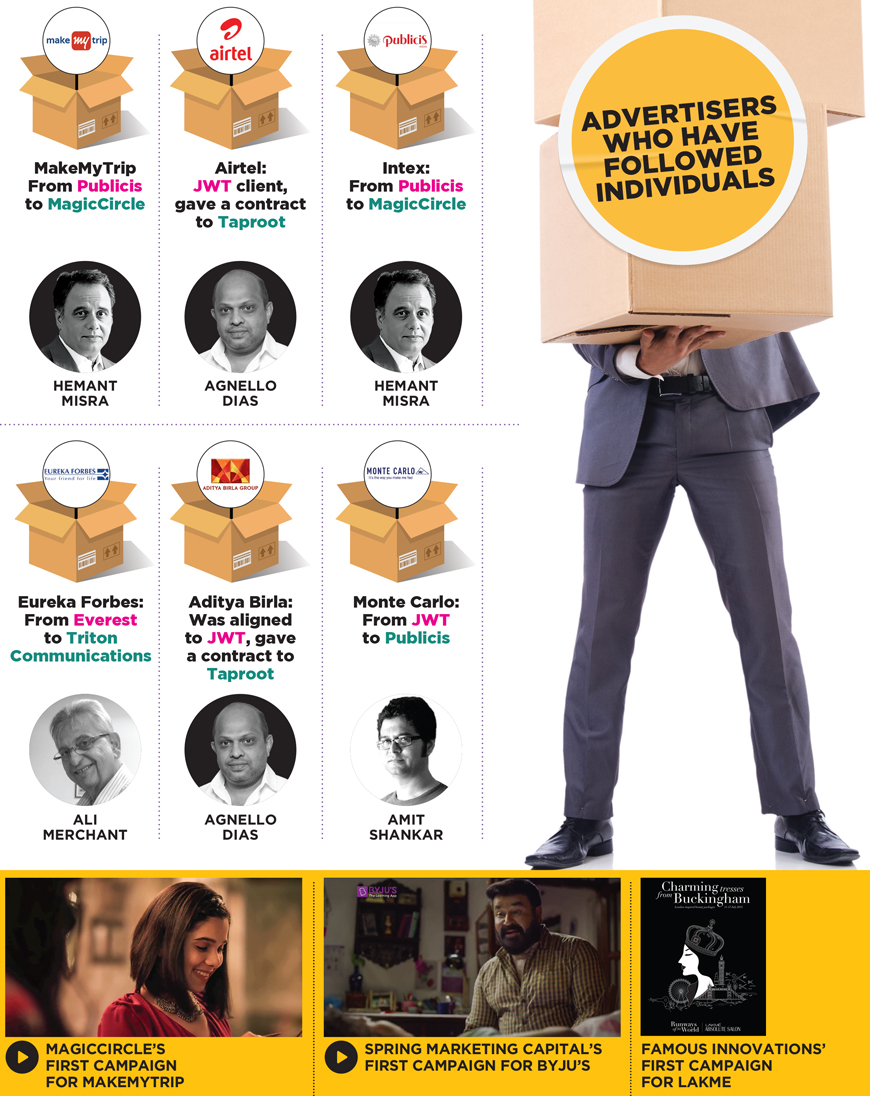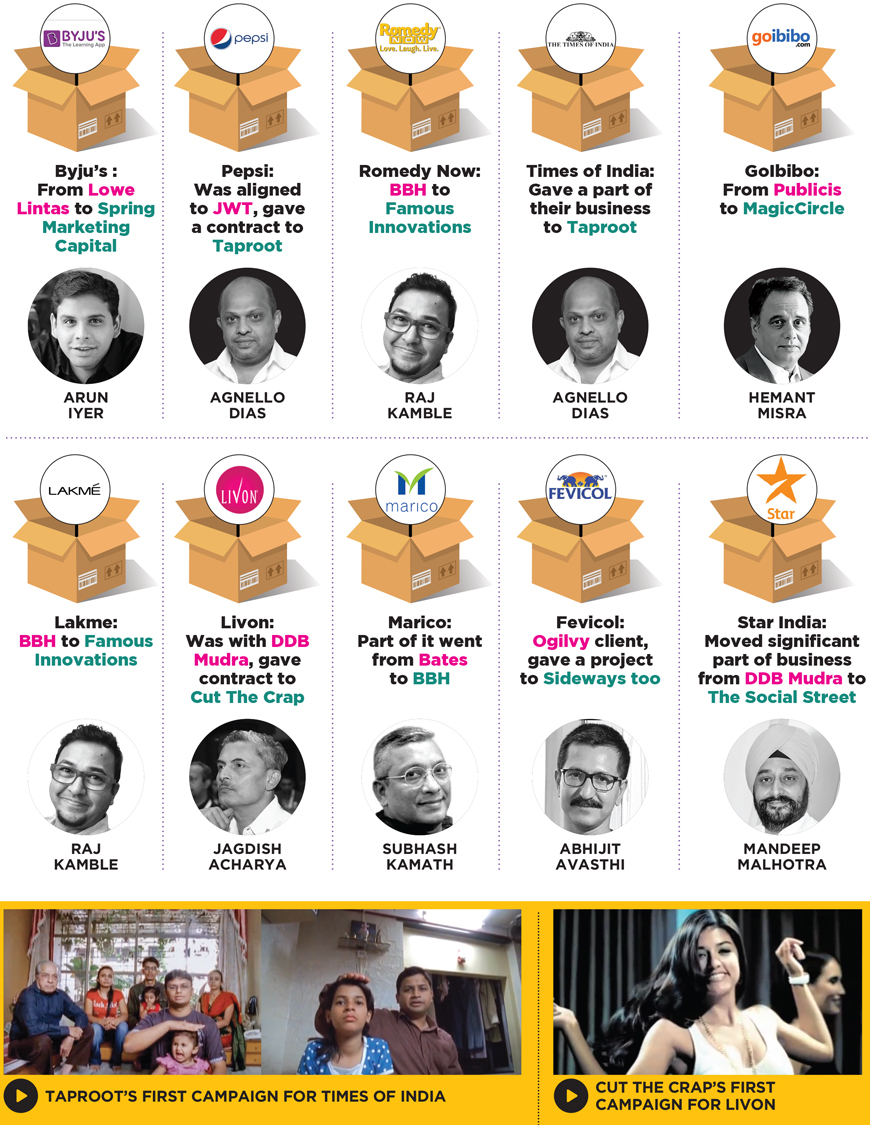WHY A NEW AGENCY?
Hemant Misra, Founder, MagicCircle says, “When I moved out of Publicis, I hadn’t thought of starting my own agency. In fact, I wanted to retire. However, my team and my clients felt that there was something we could do together. So, I agreed to try it. When an agency person starts his own firm, he needs some confidence. You can’t start an agency and then look for revenues or clients. You need to have a client to begin with, else it doesn’t work. In my case, MakeMyTrip was on board the day I began my agency and I was lucky because there was a good relationship there. I had pitched for MMT in 2015 at Publicis and won; and was deeply involved with the brand ever since. Whenever large brands move, they move only because there is a strong strategic relationship with the people who have moved.”
Bobby Pawar, now Chairman and CCO, Havas Group who was the CCO of Publicis at the time Hemant Misra won the MakeMyTrip account says, “Businesses don’t generally move even when there are very strong personalities attached to them. But if the client wants to go, what can anybody do? You have no say in the matter. Else, you have to prove that that person literally ‘stole’ the client. In examples like MakeMyTrip, there has to be a serious strain in the relationship with the client, else it wouldn’t have happened.”
GETTING A CHANCE
Two creative heads who are known to have bagged some top notch clients when they started their own agency are Agnello Dias and Santosh Padhi. Another industry leader who also later started his own agency said that when Taproot was formed, several erstwhile JWT clients gave them business, so much so that there used to be a joke in JWT saying the full form of JWT is ‘Just Went to Taproot’. Santosh Padhi, CCO and Co-founder of Taproot (now Taproot Dentsu) says, “We started our journey with Times of India. I had previously worked on the launch of Mumbai Mirror at Leo Burnett, when Priya Gupta and Rahul Kansal were our clients. Rahul Kansal was also my boss at DDB Mudra. Then Aggie did the Hockey film for Times of India. When Aggie left JWT, they wholeheartedly aligned business with us. So we started with Times of India, and some small projects. But, Times of India was the bread and butter for us for a good two years in the form of a retainer, after which we started getting other big clients like Pepsi, Aditya Birla and Airtel, who were all JWT clients.”
Explaining why such big clients gave a new agency like Taproot a chance, Padhi adds, “We had a creative structure in place, and more and more clients wanted to work with us. And people who had worked with Aggie felt they were getting more at Taproot than what they used to get in JWT. So, they gave it a shot. Obviously everything started as a project, and the project turned out to be absolutely in favour of both the parties. And then it became a long lasting relationship. Aditya Birla is still there, but unfortunately Pepsi, globally, had to take a call to align with the older agency.”
INDIVIDUAL VERSUS THE INSTITUTION
Some admen believe there is no match for agency equity. Says Rohit Ohri, CEO and Chairman FCB India, “It’s only when the agency equity is weak and there is a severe strain in the relationship that a client is forced to move on the basis of individual equity. I have worked on many global and Indian brands and for most clients, it’s a company to company relationship. So, individuals can’t really shake up a relationship or a business unless the person runs a one-man agency. For large agencies, teams usually work on the businesses. So, it’s always about the combined skill and ability of a team versus an individual. That is something that clients appreciate a lot because it also de-risks their business, because tomorrow if that one person goes somewhere else, a client can’t keep changing agencies or following that person from one agency to the other.”


Ohri, who was heading some really high profile brands like Airtel, Pepsi, Nokia and Ford at JWT, says none of the clients followed him to Dentsu when he moved. “For instance, if you take the GSK business, after JWT I moved to Dentsu. And even Swati Bhattacharya moved to Dentsu after a while, but the business didn’t move at that time. The business only moved when we came to FCB, and when there was a real brand issue which needed to be solved. It wasn’t that they just naturally said, ‘Oh, Rohit and Swati are in FCB, let’s give them the business.’ It was a full-fledged pitch. It was a global evaluation of the agency. So, skill, capabilities and everything was evaluated on the basis of the pitch. There are no free dinners and lunches anymore. Agencies are good only when they have a great multi-skill team put together and clients know that,” explains Ohri.
Echoing the same thought, Satbir Singh who moved out of FCB Ulka to start his agency, Thinkstr, three years ago says, “Even if you have a great relationship, a decent-sized brand is not going to move overnight with you. This is because you are only good at what you do in a certain kind of set-up because you have support. When you are on your own, who can say it will be same story? They might be sympathetic towards your cause, but they still would like to see how serious you are and what kind of set-up you will build.”
He adds that there are many more factors at play which influence the advertiser’s preferences: “Advertising is not about a person alone. If it is a national brand, can you service them all over, what kind of support staff you have, your turnaround time, do you have servicing support etc. Individually, you may have proved yourself. But they will wait a while to see if you can prove yourself as an agency. There are also all sorts of non-compete contracts which have stringent clauses, like you can’t hire a person from your previous organization for a certain period of time, you can’t pitch for their businesses. I didn’t bring any client with me when I started Thinkstr. When they switch, it is not because of their love for you, it is also because they are experiencing a level of dissatisfaction in their relationship with their current agency,” Singh says.
DEFECTING TO OTHER AGENCIES
Some admen say it is a lot easier when an account movement is from one big established agency to another, because the advertiser is then assured of a certain level of facilities and services, as opposed to the ambiguity that comes with a new agency. However, no matter how great a relationship some big brands have with a person in their agency team, on most occasions moving with the person is not an option because of the global alignment of the brand with an agency.
Jagdish Acharya, Founder and Creative Head, Cut the Crap says that what people equity guarantees is a chance to be heard out, even if it is not granted immediately after one starts an agency. “One may be able to pull an account towards him wherever he goes just because the equity is there; the advantage is that if he were to follow it up, then he could get a pitch called for or get an opportunity to present his ideas to a client. It has happened with us, for instance. When I moved out of DDB Mudra to start Cut the Crap, one of the agency’s clients, Livon, now a Marico brand, asked us to provide them with solutions and then they did a campaign with us a year after I started the agency. Similarly, Cycle Agarbatti was a brand that I used to handle from Bangalore for DDB Mudra. Two years later, the client first gave us a small brand to work on and then added a second one. Today, we handle the maximum number of their brands,” Acharya adds.
A few months ago, DDB Mudra’s CEO, Vineet Gupta, left the agency to start up on his own. On whether any accounts moved with him, Rahul Mathew, National Creative Director, DDB Mudra Group says, “His leaving the organisation affected our morale, not our business. In such a case, it is the agency’s job to not allow their absence to be felt, otherwise you will be in a bad place. I have mostly seen only smaller and specifically founder-driven companies follow an individual, because there is a lot of comfort with the person who is handling their account. Founder-driven companies are more about the one-on-one equation.”
A factor that helps advertisers de-risk the business and yet take a chance with a new agency is ‘projects’. Sometimes, advertisers just divert part of the business to a new agency while retaining the older agency, giving them the best of both worlds. Another reason which makes accounts move from a large agency to a newer one is obviously a rate cut. A small agency means lesser overhead cost. Some industry sources say that MakeMyTrip got a discount of more than 50% when it moved from Publicis to MagicCircle. An industry leader who didn’t wish to be named says, “The client will never pay the same amount and then move out of a big agency to a small agency; especially if he is giving you the business without a pitch, which means he is supporting your agency. So, he will need value for his buck. It works for them because the fees of large agencies tend to get bloated over a period of time and this is where the rate correction happens.”
However, Hemant Misra disagrees and says, “My remuneration didn’t change. The principle is, you pay for the hours you contribute to the business, and the output you get. If that changes, fees should change. If that doesn’t change, why should the fees change? I am not interested in discounts. If the client tells me, ‘We are paying x amount for this agency. Will you work on x minus y?’ I would certainly not, because tomorrow that will happen to me.” MakeMyTrip refused to respond to IMPACT’s queries over remuneration.
WHAT INFLUENCES AN ADVERTISER’S DECISION?
To follow or not to follow ‘trusted’ advertising agency partners to their new agency homes…
Partha Sinha and Subhash Kamath, then managing partners at BBH, started the India operations of the agency by the end of 2008, and by March 2009, Marico awarded them their business for five of its brands, the advertising budget for which was estimated to be around Rs 40 crore back then. Sinha and Kamath were first introduced to Marico during their stints at Publicis Ambience and Bates Enterprise respectively, which is believed to have helped them seal the deal.
Abhijit Avasthi started Sideways in 2015, prior to which he had a long-standing relationship with Fevicol and many other clients of Ogilvy while at the agency. When he quit Ogilvy, he didn’t take any of its clients with him but two years later, Fevicol approached him and gave him a part of the business in the form of a project even as Ogilvy continued to be their agency on record. Kawal Shoor had worked with the co-promoter of Paras Pharmaceuticals, Darshan Mehta, at Triton. Mehta founded Vini Cosmetics in 2010 and when Shoor set up his own agency, The Womb, in 2016, he followed him there, giving him the Fogg and Glam Up accounts. Similarly, sources say Monte Carlo which was associated with J Walter Thompson (now Wunderman Thompson) for a good number of years jumped to Publicis because a key resource on the agency side, Amit Shankar, joined Publicis. However, Monica Oswal, Executive Director, Monte Carlo Fashions Limited, refused to respond to IMPACT’s query on this.
While some brand marketers didn’t lose much time in following their ‘trusted’ advertising agency partners to their new agency homes, completely taking away the account from the older agency and handing it to the new, others followed a more experimental approach by awarding part of their mandate to the new agency while keeping a bulk of the work for the older agency. Then there were those who trusted the agency partner enough to move with him/her to an equally big agency, which is less risky than associating with a new agency. Yet others decided not to jump the ship till the agency professionals had started their own agency and in full control of the decisions made.
We asked some advertisers about the factors that influence their decisions and received some very interesting answers.
Shashwat Sharma, CMO, Airtel whose brand was one of Taproot’s earliest clients, says, “I am a believer in people, agencies are ultimately about people who are driving the brands. The agency can give you a great team or an average team. I believe and bet on people. It is not like Taproot is better and Wunderman Thompson is worse. We don’t anyway work with one agency alone, there is Taproot Dentsu, Wunderman Thompson, Webchutney, Glitch and a few others. There is enough work for all from a brand perspective. There is an ecosystem and environment of trust in which we work with all of them, depending on what they bring to the table and all of them have really good teams working with us. But if someone from Taproot is branching out and that is the go-to person for us at Airtel, then yes, we will give him a chance.”
For Nipun Marya, Director, Brand Strategy, Vivo India a brand which has worked with multiple agencies like Dentsu, BBH, Publicis and Ogilvy, it is a difficult choice to make. “I believe the institution is bigger than the individual. In an agency, while a person may be very important, it’s not only because of that one person that the good work is happening, it’s always team work. It’s the whole culture of that agency and a combination of many things which gives that creative output. The power of the institution is bigger than the power of an individual.”
The decision is, however, clearer whenever a brand is aligned with an agency globally; rarely has one seen a multinational brand follow an individual to another agency. In the case of Reckitt Benckiser, which is globally associated with Havas Group, the decision is easy. Abhishek Chuckarbutty, Global Category Director, Reckitt Benckiser, Hygiene Home elaborates, “You build a lot of trust and relationships with an agency, which knows your brand; so they are strategic partners that help you develop a brand. Fundamentally, the agencies have a lot of consumer understanding, they build equity with us as partners, it is a journey which is not people dependent, it is brand building. It is not transactional and is done over a period of time. We won’t desert the ship just because one person left.”
For younger and upcoming brands like Byju’s, the logic is totally different. Byju’s recently followed Arun Iyer from Lowe Lintas to his new venture Spring Marketing Capital. Atit Mehta, Marketing Head, Byju’s says, “In creative agencies, people equity is very important. If the creative director or the creative head who runs your business or communication piece has had some success stories, and has been associated with you for a long period of time, in the event he or she is moving out, the agency equity will take second seat and the person equity will take prominence. The brands will move with the creative person. That doesn’t happen in media agencies.”
Years ago, Eureka Forbes disassociated with Everest and moved along with Ali Merchant when he was starting his own agency Triton Communications. It became one of the longest partnerships in the history of Indian advertising. Years later, talking about whether the brand is willing to move if it sees an important talent leave the current agency it is associated with, Sameer Wanchoo, CMO, Eureka Forbes says, “People working day to day on the account are more important than possibly the leaders who appear in pitches. It has also been our experience that an agency with a positive equity attracts the best talent. But this norm is now getting challenged with the mushrooming of creative hotshops. We associate with proven creative talent who may have branched out towards niche but creatively inspiring avenues. Gone are the days of ‘one TVC fits all’. With so many copies and creatives to be made across different mediums, the era of specialized agencies and ideas from varying sources has truly begun. One only has to keep his eye open and spot the real diamond.”
Havells, which has been associated with Mullen Lintas for a long time, has a different view. Amit Tiwari - Vice President Marketing, Havells India Ltd says, “In today’s day and age only one particular person driving your brand from the agency side and you following him/her is just not right, and it is not an approach I follow. A good leader can have an idea but if the orchestration of the idea is not done right and thought properly, the brand will suffer, which is why a team becomes important. To give an example, Ogilvy is very creative-driven whereas JWT is very servicing-led. If one resource moves from Ogilvy to JWT, firstly to get into the entire ecosystem would be difficult, forget about delivery. The brand will then suffer in the process if it has followed the individual. I know of a case where brands like Nestle and L’oreal moved from Universal McCann to Zenith Optimedia following someone but within a year, the agency team which moved from Universal McCann to Zenith Optimedia moved out. What purpose did the move serve then?”
 Atit Mehta
Atit MehtaMarketing Head, Byju’s
In creative agencies, people equity is very important. If the creative director or the creative head who runs your business has had some success stories, and has been associated with you for a long period of time, in the event he or she is moving out, the agency equity will take second seat and the person equity will take prominence. The brands will move with the creative person.
 NIPUN MARYA
NIPUN MARYADirector, Brand Strategy, Vivo India
I believe the institution is bigger than the individual. In an agency, while a person may be very important, it’s not only because of that one person that the good work is happening, it’s always team work. It’s the whole culture of that agency and a combination of many things which gives that creative output. The power of the institution is bigger than the power of an individual.
WHAT ARE THE LEGAL IMPLICATIONS?
Earlier this year, industry sources spoke about a weird challenge that Lowe Lintas was facing with two of its former captains, Joseph George and Arun Iyer, having started their own agencies and the agency’s clients being divided on loyalties. However, not much is known yet on which accounts have moved to the new agencies, except Byju’s which followed Arun Iyer to Spring Marketing Solutions. We asked the stakeholders about the new scenario. We also asked other agency heads on rules they need to follow in case they want to work with the clients they have had a good relationship with from their previous agencies.
 Arun Iyer, Founder and Creative Partner, Spring Marketing Capital, says, “The truth of the matter is that Raja (Ganapathy) and I had worked so closely on brand Byju’s, that when we came together, Byju naturally said, ‘Hey, you are the guys who have built this brand and we will have to work with you.’ So, it was a very natural progression because Raja is from Sequoia which was an early investor in Byju’s. For three years, we have been working on the brand.”
Arun Iyer, Founder and Creative Partner, Spring Marketing Capital, says, “The truth of the matter is that Raja (Ganapathy) and I had worked so closely on brand Byju’s, that when we came together, Byju naturally said, ‘Hey, you are the guys who have built this brand and we will have to work with you.’ So, it was a very natural progression because Raja is from Sequoia which was an early investor in Byju’s. For three years, we have been working on the brand.”On the risks involved in associating with a new partner company, Atit Mehta, Marketing Head, Byju’s says, “The Shah Rukh communication as well as the Disney-Byju’s communication were done by Arun Iyer, but under Spring and not Lowe - and that is exactly how we wanted it. It’s not a gamble, because most agencies anyway outsource a lot of stuff like production. The account generally moves with the senior guys, and if he is moving to another agency set-up, he will have all infrastructure required. If the creative person is starting something of his own, he will take key people along and everything else can be outsourced. As for legal issues about breaking ties with our former agency, we were very clear about wanting to move and it was worked out. All that is manageable.”
On whether a non-compete clause has prevented him from pitching for other Lowe Lintas clients, Iyer says, “One, we very rigidly follow the ‘no pitching’ rule and two, there is absolutely no clause. After all, I have been a fossil in that system and I had signed my contract like 17-18 years ago.”
On the other hand, Joseph George, Chairman and MD, Tilt Brand Solutions, says, “Some clients do work with individuals and some clients work with institutions. The latter do so because they want a buy-in to everything - the product, the process and the culture of the institution as well. Lintas has been fortunate, that most if not all of its clients have always checked into Lintas - the institution. It is in the context of this belief of mine, that all the senior exits from Lintas in the last three odd years have not impacted the agency one bit in terms of any significant attrition of talent or clients. The last 12 months of Lintas has been its best in a long time in terms of new business acquisition.”
While George was quick to say that none of the senior exits from Lintas have impacted the agency’s business, he was not as forthcoming while talking about clients Tilt Brand Solutions has won over the past months and most importantly, if any of them were earlier working with Lintas. While saying that an announcement to the effect will be made in September, he adds, “About 80% of our business today is a result of inbound requests. Our new business acquisition strategy is primarily based on our assessment on which clients, categories and brands can we deploy the Tilt Way.”
Sagar Kapoor, CCO, Lowe Lintas, who has been with the agency for over 15 years, is a strong advocate of agency equity over people equity. He says, “It’s not about giving an idea and getting out of a situation. If that was the case, then the industry would have been full of consultants. We have to handhold the idea till it reaches its perfect execution which requires an entire team. I have been handling Lifebuoy for 10 years but tomorrow, if I quit Lintas, Lifebuoy won’t necessarily follow me. After I became CCO and got a wider role, others in the team are taking good care of brand Lifebuoy, just as well as I did.”
Talking about Iyer and George, Kapoor says, “I can’t generalize that they are pitching for Lowe’s clients, that’s not the scenario, but again it is not in my purview to speak on it right now.”
Ajay Gahlaut, Chief Creative Officer & Managing Director, Publicis Worldwide India, presents another school of thought: “I know there are non-compete clauses, but I am not certain how rigorously they are implemented. At the end of the day, if the client decides to move, it is the client’s free will. It’s not like someone can drag a client away from an agency. If the client is happy with that agency, why would he want to move? You can’t say you took my client away. The client decides to move. So, that’s a grey area. In the Indian scenario, I haven’t heard of a case wherein an agency has taken a former employee to court over taking a client away.” Gahlaut is clear that he has not taken any Ogilvy client or pitched for any of them since he moved to Publicis from Ogilvy a few months ago. “If the standard of work remains the same, I don’t see any point in a client wanting to move with an individual or undergo the hassle of a pitch process all over again,” he observes.
Taking a tougher line, Dheeraj Sinha, MD, India & Chief Strategy Officer, South Asia, Leo Burnett says, “We have all the heart for people moving on and doing greater things. We take pride in our alumni setting the world on fire. However, we can’t ever allow that at the cost of our organisation. We have very stringent non-compete clauses and there are strict legal recourses available in case there is a breach of faith - when employees try to steal clients. That’s at the legal level. However, if individuals are able to steal a client, that is the organisation’s failure. It takes many people to create path-breaking output for a client and build a successful brand. The relationship with the client, therefore, is at multiple levels. It’s never driven by one person or personality. It’s at the level of the organisation and not one individual. It’s impossible for individual employees to steal clients when they leave.”
Others like Abhijit Avasthi, Founder, Sideways, call it a matter of ethics to not poach clients. Says Avasthi, “When I was leaving Ogilvy to start Sideways, I was very clear that I would not be starting off with either Ogilvy clients or Ogilvy people. That’s my relationship with Ogilvy, it’s just basic decency towards an organization that built me for 15 years. Poaching Ogilvy’s clients doesn’t work for me, it’s not the right thing in my book. Till date, I have worked with only two ex-Ogilvy clients and that too years after I started Sideways and one of them was in collaboration with Ogilvy.”
A fresh perspective comes from Raj Kamble, Founder Famous Innovations who says, “When I left BBH after working for five months, I had a contract which said that I could not take any client with me. But clients like Lakme, Movies Now and Romedy Now called me. I conveyed that I couldn’t immediately work with them and agreed to wait for a year, after which they came on board. The younger heads of companies don’t care about the legacy of the agency or the past bond; they just want someone who can solve their problems. I am probably the first agency head who will tell my employees who are starting their own agency to take my business if they have a relationship with my client, I would not insert any non-compete clauses. In fact, I will help him/her start their own agency. I believe that clients should go with the person who is solving their problem, and it is great if a person has the type of relationship with a client which makes a client want to follow him/her.”
Pratap Bose, Founding Partner and Chairman, The Social Street who reportedly took away many clients from DDB Mudra when he started his agency says, “Indians are very clever about circumventing the rule. The easiest is to say, ‘I never approached the client. The client approached me. I didn’t poach the client’. In my case, DDB Mudra obviously did create circumstances which made it difficult for me, but it boils down to the fact that if the client doesn’t have a problem, you are safe and secure. There is very little anyone can do, unless you signed contracts which are time-bound and irrevocable. I’d like to add that not every client moved with us straightaway, some moved six months later, some moved a year later and others two years later, depending on their contract. On my side, I couldn’t handle or compete, even look at, or sniff at anyone for a period of one year. But by the time I started my agency officially, it was already one year.”
Almost three decades ago, when Ali Merchant and Munawar Syed moved from Everest to Triton to start their own agency, two brands namely Apple Industries (now Aptech) and Eureka Forbes moved to their new agency with them. Explaining how that happened, Ali Merchant, Founder and Director, Triton Communications says, “It was very funny because I had pitched for Aptech and won the business. But around the same time we decided to start our own agency. Before they could sign up, I had decided to move on. And they said, ‘Okay, we will move with you.’ This is because they had confidence in me as I was leading the pitch. Eureka Forbes, on the other hand, was a brand I had handled for 5-6 years at least. Non-compete clauses were not there at that time. Today, it is there but for very senior people. I was a lawyer before I got into advertising and let me tell you if a client wants to go, he goes, and any clause you can easily get around, if needed.”
 Joseph George
Joseph GeorgeChairman and MD, Tilt Brand Solutions
Some clients do work with individuals and some clients work with institutions. The latter do so because they want a buy-in to everything - the product, the process and the culture of the institution as well. Lintas has been fortunate, that most if not all of its clients have always checked into Lintas - the institution.
 Pratap Bose
Pratap BoseFounding Partner and Chairman, The Social Street
DDB Mudra obviously did create circumstances which made it difficult for me, but if the client doesn’t have a problem, you are safe and secure. There is very little anyone can do, unless you signed contracts which are time-bound and irrevocable. Not every client moved with us straightaway, some moved six months later, some moved a year later and others two years later, depending on their contract.
























